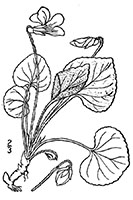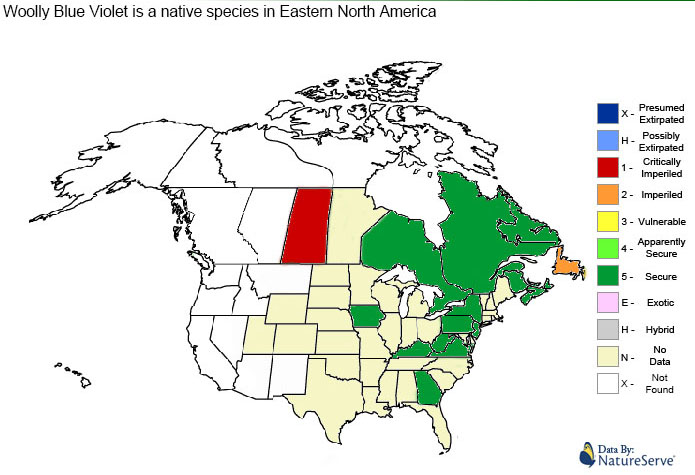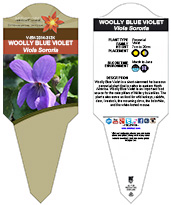

| Plant Name | Woolly Blue Violet | |
| Scientific Name | Viola Sororia | |
| Family | Violet | |
| Plant Type | Perennial | |
| Start of Blooming Season | March | |
| End of Blooming Season | June |

| Soil Conditions | |
| Soil Moisture | |
| Sunlight | |
| Notes: |

Woolly Blue Violet is a perennial plant that grows 7.5cm to 20cm tall with woolly haired stems. The leaves are cordate (heart shaped) and are 1cm to 10cm wide. The leaves of woolly blue violet have a crenate margin with cross-venulate venation. The flowers of woolly blue violet are bilaterally symmetrical and grow in clusters on a stalk that is 5cm to 15cm long. Flowers can be deep blue, Violet, Lavender, or white with five petals. Each flower is 18mm to 25mm wide and contains five stamens and five pistils. Woolly Blue Violet produces a mottled green fruit capsule which is 6mm to 12mm long. Self-seeding freely, in lawns and gardens it can be considered a weed by some. Cleistogamic seed heads may also appear on short stems in late summer and early autumn.

| Plant Height | 7.5cm to 20cm |
| Habitat | Moist Meadows, Rich Woods |
| Leaves | cordate 1cm to 10cm wide |
| Leaf Margin | Crenate |
| Leaf Venation | Cross-venulate |
| Stems | Hairy stems |
| Flowering Season | March to June |
| Flower Type | Bilaterally Symmetrical |
| Flower Colour | Blue, Violet, White |
| Pollination | Bees |
| Flower Gender | Flowers are hermaphrodite and the plants are self-fertile |
| Fruit | small mottled green fruit capsule |
| USDA Zone | 4A (-31°C to -34°C) cold weather limit |

No known health risks have been associated with woolly blue violet. However ingestion of naturally occurring plants without proper identification is not recommended.

 |
-Click here- or on the thumbnail image to see an artist rendering, from The United States Department of Agriculture, of woolly blue violet. (This image will open in a new browser tab) |

 |
-Click here- or on the thumbnail image to see a magnified view, from Go Botany, of the seeds created by woolly blue violet for propagation. (This image will open in a new browser tab) |

Woolly Blue Violet can be referenced in certain current and historical texts under the following seven names: Woolly Blue Violet can be translated into the following select languages: |
|||||||||||||
| Arabic | الأزرق البنفسجي الصوفي | Bulgarian | вълна синьо виолетово | Chinese (Sim) | 羊毛蓝紫色 | ||||||||
| Croatian | vuneno plavo ljubičasto | Czech | vlněný modrý fialový | Danish | uldblå violet | ||||||||
| Dutch | Esperanto | lano blua viola | Estonian | villane sinine violetne | |||||||||
| Finnish | villan sinistä violetti | French | laineux bleu violet | German | wollig blauviolett | ||||||||
| Greek | μάλλινο μπλε ιώδες | Hebrew | צבוע כחול סגול | Hungarian | gyapjas kék lila | ||||||||
| Italian | viola blu lanoso | Japanese | ウールブルーピンク | Korean | 털리 블루 바이올렛 | ||||||||
| Punjabi | ਨੀਲੀ ਨੀਲਾ ਵਾਇਟਲ | Lithuanian | vilna mėlyna violetinė | Norwegian | ullblå fiolett | ||||||||
| Persian | بنفش بنفش آبی | Polish | wełnisty niebieski fioletowy | Portuguese | violeta azul lanoso | ||||||||
| Romanian | Russian | шерстяной синий фиолетовый | Slovak | vlna modrá fialová | |||||||||
| Spanish | azul violeta lanoso | Swedish | ullblå violett | Tagalog | makapal na asul na lila | ||||||||
| Turkish | yünlü mavi menekşe | Ukrainian | шерстяна синя фіалка | Vietnamese | tím xanh tím | ||||||||

| The information provided in this conservation assessment has been provided by the Natureserve Database in conjuction with various federal, provincial, state, county, district, regional, and municipal governments as well as public and private conservation authorities. Information in this section is accurate from the last time this article was updated. |
|
 |
Woolly Blue Violet is considered to be a secure native species in North America. |

 |

 |
The MIROFOSS database offers free printable garden tags for personal and non-profit use. These tags can be used to properly identify plant samples in a garden. Click on the tags shown on the the screen or -click here- to download a full size jpeg image for a woolly blue violet identification tag; which can be printed on paper or used with a plastic laser printer. |
 |
What's this? What can I do with it? |

| Description | Dickinson, T.; Metsger, D.; Bull, J.; & Dickinson, R. (2004) ROM Field Guide to Wildflowers of Ontario, Royal Ontario Museum, Toronto:McClelland and Stewart Ltd. |
| Description | Kartesz, J.T. 1994. A synonymized checklist of the vascular flora of the United States, Canada, and Greenland. 2nd edition. 2 vols. Timber Press, Portland, OR. |
| Description | Mabey. R. Plants with a Purpose. Fontana 1979 ISBN 0-00-635555-2 |
| Folklore | MacKinnon, Kershaw, Arnason, Owen, Karst, Hamersley, Chambers. 2009. Edible & Medicinal Plants Of Canada ISBN 978-1-55105-572-5 |
| Image Rendering | USDA-NRCS PLANTS Database / USDA NRCS. Wetland flora: Field office illustrated guide to plant species. USDA Natural Resources Conservation Service. |
| Environment | National Audubon Society. Field Guide To Wildflowers (Eastern Region): Alfred A. Knopf. ISBN 0-375-40232-2 |
| Physical Identification | National Audubon Society. Field Guide To Wildflowers (Eastern Region): Alfred A. Knopf. ISBN 0-375-40232-2 |
| January 29, 2018 | The last time this page was updated |
| ©2021 MIROFOSS™ Foundation | |
 |